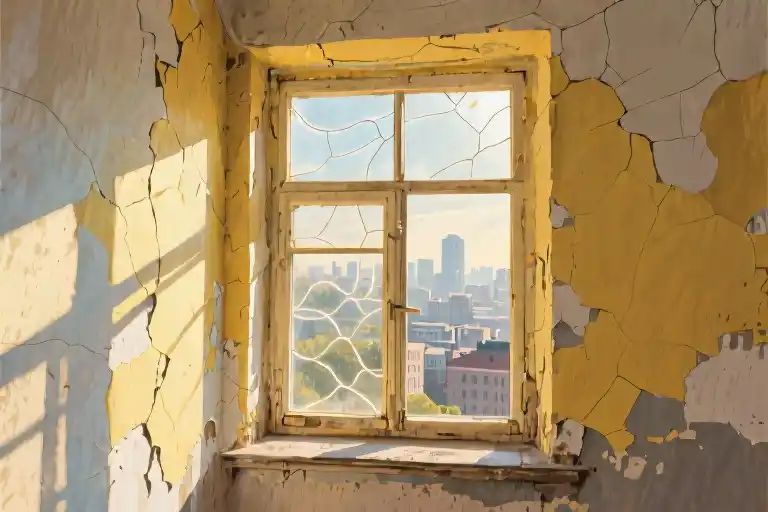The thirteenth-floor emergency exit staircase of this heritage brick building has become my accidental sanctuary. Pressing my palms against the cool metal railing, I watch the city unfold below through segmented panes of wavy glass – each window frame a brushstroke of cheerful yellow oil paint that’s cracked with age but still defiantly bright.
March wind carries the salt-tang of the nearby docks, mingling with the earthy promise of thawing soil. Below, bicycles weave through pedestrians like steel-and-neon fish, their spokes catching sunlight in fleeting flashes. Across the street, darkened apartment windows hold mysteries in their reflections, while further out, the grain elevator stands sentinel over sailboats bobbing in bottle-green water. The first spring buds dot the trees like hesitant green confetti.
My right thumb twitches against my jeans pocket. That familiar itch – the impulse to capture, to share – rises before I can name the quality of light making the century-old window frames glow. The muscle memory is startling in its precision: unlock phone, open camera, adjust exposure, tap to focus. My fingers actually curve around an invisible device before I catch myself.
(If I’m honest, the three photos I eventually snapped – and immediately disliked – flatten the scene into something unrecognizable. No algorithm can compress the way the wind smells like snowmelt and diesel, how the rusty hinge squeaks when I lean forward, or how the sunlight warms my left cheek while the shaded right stays cool.)
“This would get good engagement,” whispers the ghost of my social media self. The thought arrives fully formed, unbidden, like a pop-up ad from my own brain. Even now, years after quitting daily posting and weeks after deleting the apps, this reflex persists – the urge to turn experience into content, to distill living into likes.
That quiet moment of tension – between wanting to preserve and needing to participate – might be the defining sensation of our digital age. When you last encountered something beautiful, did your hand reach for your phone before your mind reached for words? When a sunset stops you in your tracks, do you watch it until it’s gone, or until you’ve gotten the shot?
The window frames divide the view into manageable rectangles, just as our devices frame our experiences into shareable squares. But what slips through the cracks between those frames? What happens when we mistake the curated tile for the mosaic, the filtered snapshot for the lived moment?
Perhaps you know this tug-of-war too: the part of you that wants to be present wrestling with the part that’s been trained to perform. The good news? Noticing that conflict is the first step toward rewiring those automatic responses. That glimmer of awareness – like the first green buds outside this very window – is where change begins.
The Fragmented View: How Our Devices Frame Reality
Standing thirteen floors above the city, the view unfolds like a living postcard – bicycle messengers weaving through historic streets, sunlight dancing on the river’s bottle-green surface, those first tentative buds on maple branches signaling winter’s retreat. My fingers twitch toward my phone pocket in automatic response, a muscle memory more reliable than my actual recollections of last Tuesday’s lunch.
The Statistics of Seeing
Research from Pew Center reveals the average smartphone user now captures 23 photos daily, with 68% immediately shared on social platforms. We’ve become curators of our own lives, collecting moments like seashells – not for their inherent beauty but for their display potential. A University of California study found that museum visitors spend 87% of their viewing time photographing artworks rather than observing them directly, their experience mediated through camera screens.
The Cognitive Window Frame
Our devices function as digital fenestration – architectural elements that both reveal and constrain our view. Like the segmented vintage window frames in my stairwell, smartphones:
- Select what enters our awareness (cropping reality to 4:3 ratios)
- Filter raw experience (through Valencia or Clarendon presets)
- Redirect attention from sensation to presentation
Neuroscientist Dr. Rebecca Klein notes: “When we frame a shot, we activate the brain’s prefrontal cortex – the same region used for future planning. Essentially, we stop experiencing the present to anticipate others’ reactions.”
Tourist Eyes vs Resident Vision
Consider two approaches to the same cityscape:
| Tourist Mode | Local Mode |
|---|---|
| Seeks iconic angles | Notices seasonal changes |
| Captures for later sharing | Absorbs for immediate pleasure |
| Experiences through viewfinder | Engages all senses |
| Creates content | Creates memories |
Photographer Elena Ruiz describes her shift: “After ten years documenting Paris for Instagram, I realized I’d never felt the cathedral gargoyles’ rough texture or noticed how chestnut blossoms smell like honey. My followers knew my city better than I did.”
This compartmentalization extends beyond travel. At concerts, we watch performances through smartphone screens. At family dinners, we interrupt conversations to document meals. Even during solitary walks, we mentally compose captions for nonexistent audiences. The cognitive window frame becomes a permanent filter, altering not just what we see but how we see.
The Cost of Constant Framing
- Memory Formation: MIT research shows photographed details are 27% less likely to be remembered than observed ones
- Emotional Depth: Brain scans reveal reduced amygdala activation during photographed vs directly experienced moments
- Sensory Richness: The average social media post utilizes 1.8 senses (sight, occasionally sound), while lived experiences engage all five
As I lower my unused phone, the scene before me shifts. The window frame’s chipped paint becomes part of the composition, the distant laughter of street performers enters awareness, the metallic chill of the railing registers against my palm. For this moment, the view belongs only to me – uncurated, unfiltered, gloriously complete.
The Dopamine Trap: Why We Can’t Stop Sharing
That automatic reach for your phone when you see something beautiful? It’s not just you – it’s your brain chemistry at work. Modern neuroscience reveals how social media platforms have hijacked our natural reward systems, turning casual sharing into compulsive behavior.
The Brain’s Reward Circuit Explained
Every time you post that sunset photo and wait for likes, your brain undergoes a measurable chemical reaction:
- Anticipation Phase: As you compose your post, dopamine levels rise in anticipation of social validation
- Notification Spike: Each like or comment triggers a 15-25% dopamine increase (Harvard Social Cognitive Neuroscience Lab, 2022)
- Variable Reinforcement: The unpredictable timing of responses mimics slot machine mechanics
This cycle creates what psychologists call intermittent reinforcement – the same mechanism that keeps gamblers pulling levers. Your brain learns that sharing might bring pleasure, so it pushes you to repeat the behavior, even when the actual satisfaction proves fleeting.
Skinner Boxes in Our Pockets
Social platforms employ deliberate design strategies to exploit these neural pathways:
- Red Dot Notifications: Visual triggers that activate our threat detection system
- Endless Scroll: Removes natural stopping points to prolong engagement
- Algorithmic Feed: Curates content to maintain optimal engagement arousal
These features transform our smartphones into digital Skinner boxes – psychological experiments where random rewards condition us to keep checking our devices. The average user now touches their phone 2,617 times daily (Dscout Research), with most checks lasting less than 30 seconds – just long enough to get another microdose of validation.
The Hidden Cost of Constant Sharing
While posting that perfect brunch photo might feel satisfying in the moment, this behavior comes with cognitive consequences:
Experience Fragmentation
Dividing attention between experiencing and documenting reduces memory encoding by up to 40% (University of California attention studies). Your brain can’t fully process an event while simultaneously framing it for external consumption.
Emotional Blunting
The dopamine spikes from virtual validation create tolerance over time, requiring more frequent or dramatic posts to achieve the same satisfaction. Many users report feeling emotionally detached from experiences they’ve overshared.
Decision Fatigue
From filter selection to caption crafting, the micro-decisions involved in curating online presence deplete mental energy that could fuel genuine enjoyment.
Rewiring the Response
Understanding these mechanisms is the first step toward healthier digital habits. In the next section, we’ll explore practical sensory retraining techniques to reclaim your attention and deepen real-world experiences. For now, simply notice: how does your body react when you resist the urge to share? That space between impulse and action is where true agency begins.
Sensory Rehabilitation Plan
The 5-Minute Sensory Isolation Challenge
Begin by finding any ordinary moment – your morning coffee steam curling upward, sunlight patterning through blinds, or even the rhythmic sound of your own breathing. Set a timer for 5 minutes and:
- Device Detox: Place phones out of reach (not just silent) to remove the physical temptation
- Anchor Sense: Choose one sensory channel to focus on (e.g. track five distinct sounds)
- Detail Hunting: Notice three microscopic details you’d normally miss (that crack in the teacup’s glaze)
- Kinesthetic Check: Scan bodily sensations – is the wind cooler on your left wrist? Shoes tighter on the right foot?
- Delayed Capture: Only after the timer, decide if recording would enhance or diminish the experience
Pro Tip: Start with mundane objects to avoid the “this is too beautiful not to share” pressure. The grocery store checkout line makes excellent training ground.
Alternative Documentation Toolkit
When the urge to digitally capture overwhelms, try these analog preservation methods:
1. Haiku Journaling (Visual)
Distill the scene into:
- 5 syllables for textures
- 7 syllables for colors
- 5 syllables for emotional residue
Example:
“Peeling blue paint chips (5)
Dandelion cracks through concrete (7)
Childhood summers hum (5)”
2. Sound Sketching (Auditory)
Use voice memos to:
- Describe the scene blindfold-style
- Imitate ambient noises with your voice
- Record the silence between sounds
3. Tactile Time Capsules (Physical)
Keep a “texture diary” with:
- Pocketed found objects (acorn, subway ticket)
- Rubbings of interesting surfaces
- Fabric swatches representing moments
Digital Cooling System
Create friction between impulse and sharing with these filters:
- The 24-Hour Rule
Save drafts in a private folder labeled “Future Me’s Surprise” – most lose their urgency by tomorrow - The 3-Question Gate
Before posting, ask:
- Am I sharing this for connection or validation?
- Does this capture my full experience?
- Would I enjoy this moment without witnesses?
- The Context Requirement
Only allow shares that include:
- One sensory detail not visible in the image
- One personal memory it triggered
- One question for the audience
Remember: These aren’t restrictions but lenses – like adjusting a camera’s focus ring until the blurry shapes become distinct leaves on a tree. The more we practice sensory rehabilitation, the richer our unmediated experiences become.
The Dialectics of the Window Frame
The Evolution of Framing in Art History
The impulse to capture and share our experiences through digital frames isn’t as modern as we might think. For centuries, artists have grappled with the same fundamental question: how does the act of framing shape our perception of reality?
From Renaissance painters who used architectural elements to guide the viewer’s eye, to Impressionists who experimented with unconventional cropping, the history of art reveals our enduring struggle with selective perception. The Japanese concept of ‘miegakure’ (appearing and disappearing) in ukiyo-e prints particularly resonates today – these artworks intentionally showed partial views, reminding viewers that reality extends beyond the frame.
Contemporary photographer Henri Cartier-Bresson’s ‘decisive moment’ philosophy takes on new meaning in our age of constant sharing. His belief that composition must happen in-camera, not through later cropping, offers an antidote to our current filter-and-retouch culture. Perhaps we might adopt his approach: experiencing first, capturing second – and only when the moment truly demands it.
The Aesthetic Value of Imperfect Experience
There’s an unexpected beauty in experiences that escape digital documentation. The slight blur of a moving train window, the imperfect recollection of a sunset’s colors, even the frustrating gaps in our memory – these ‘flaws’ create space for personal interpretation and emotional resonance that polished Instagram posts often lack.
Neuroscience supports this counterintuitive idea. Studies at University College London found that slightly imperfect visual information actually enhances memory encoding. Our brains work harder to reconstruct incomplete sensory data, creating deeper neural pathways. That hastily-snapped, poorly-lit photo you almost deleted? It might contain more authentic memory triggers than your carefully curated gallery.
Consider implementing these practices:
- The 70% Rule: Deliberately capture only partial views of special moments
- Sensory Anchors: Choose one non-visual element (a scent, texture, or sound) to focus on instead of photographing
- Delayed Processing: Wait at least 24 hours before editing or sharing any images
Developing a Personal Sharing Ethic
In an era where sharing has become reflexive, we need conscious frameworks to guide our digital interactions. A personal sharing ethic isn’t about strict rules, but about creating mindful pauses between experience and documentation.
Start by asking these questions before posting:
- Motivation Check: Am I sharing to enhance this experience or to perform it?
- Temporal Test: Will this still feel meaningful in 48 hours?
- Sensory Audit: Have I fully absorbed this through at least three senses?
- Privacy Calculus: What am I gaining versus what I’m giving up by sharing this?
Technology ethicist Tristan Harris suggests designing ‘speed bumps’ into our sharing habits. This could mean:
- Setting physical reminders (a small sticker on your phone camera)
- Creating a ‘digital holding pen’ folder for images to review later
- Establishing themed sharing days (#TextureTuesday vs. constant posting)
The window frame of our devices will always mediate our experience to some degree. But by understanding its artistic heritage, embracing imperfection, and developing conscious sharing practices, we can transform these frames from limitations into thoughtful compositional tools. After all, even the most beautiful stained glass window was meant to be looked through – not at.
Returning to the Window
Back at the thirteenth-floor window, something shifts when the phone stays in my pocket. The oil-painted frames no longer feel like borders to crop against, but guides for the eyes – directing attention to new details that escaped the first glance:
- The way afternoon light transforms the brick walls into a patchwork of amber and rust
- A faint rhythm of jazz floating up from the street musician three blocks away
- The warmth of aged wood under fingertips that remember every brushstroke
This is the paradox we’ve uncovered: the very tools meant to capture experience often become barriers to truly having it. Yet when we resist the initial impulse to document, the world offers second gifts – deeper textures, quieter moments, unanticipated connections.
The 30-Second Sensory Challenge
Next time beauty stops you in your tracks:
- Pause (5 sec): Feel your feet grounded before reaching for any device
- Breathe (10 sec): Inhale the scene with all five senses
- Choose (15 sec): Decide consciously – will this be:
- A private mental snapshot?
- A sensory note (voice memo/text)?
- A shared moment (with present company first)?
This tiny ritual creates what neurologists call a “cognitive buffer” – that crucial space between stimulus and response where freedom lives.
Your Turn: The Unrecorded Moments Archive
We’re collecting stories of experiences made richer by their lack of documentation:
“The lavender sunset in Portugal that lives only in my memory – no filter could match how the light made the cobblestones glow.” – Rafael, Lisbon
“My daughter’s first steps happened while my phone was charging. That imperfect memory is more vivid than any video.” – Simone, Toronto
Share yours in the comments: Which undigitized memory lives brightest in your mind? Let’s build an anthology of analog moments that no algorithm can replicate.
(Pro Tip: Bookmark this page – when the share impulse strikes, revisit these stories as reminders of life beyond the feed.)





